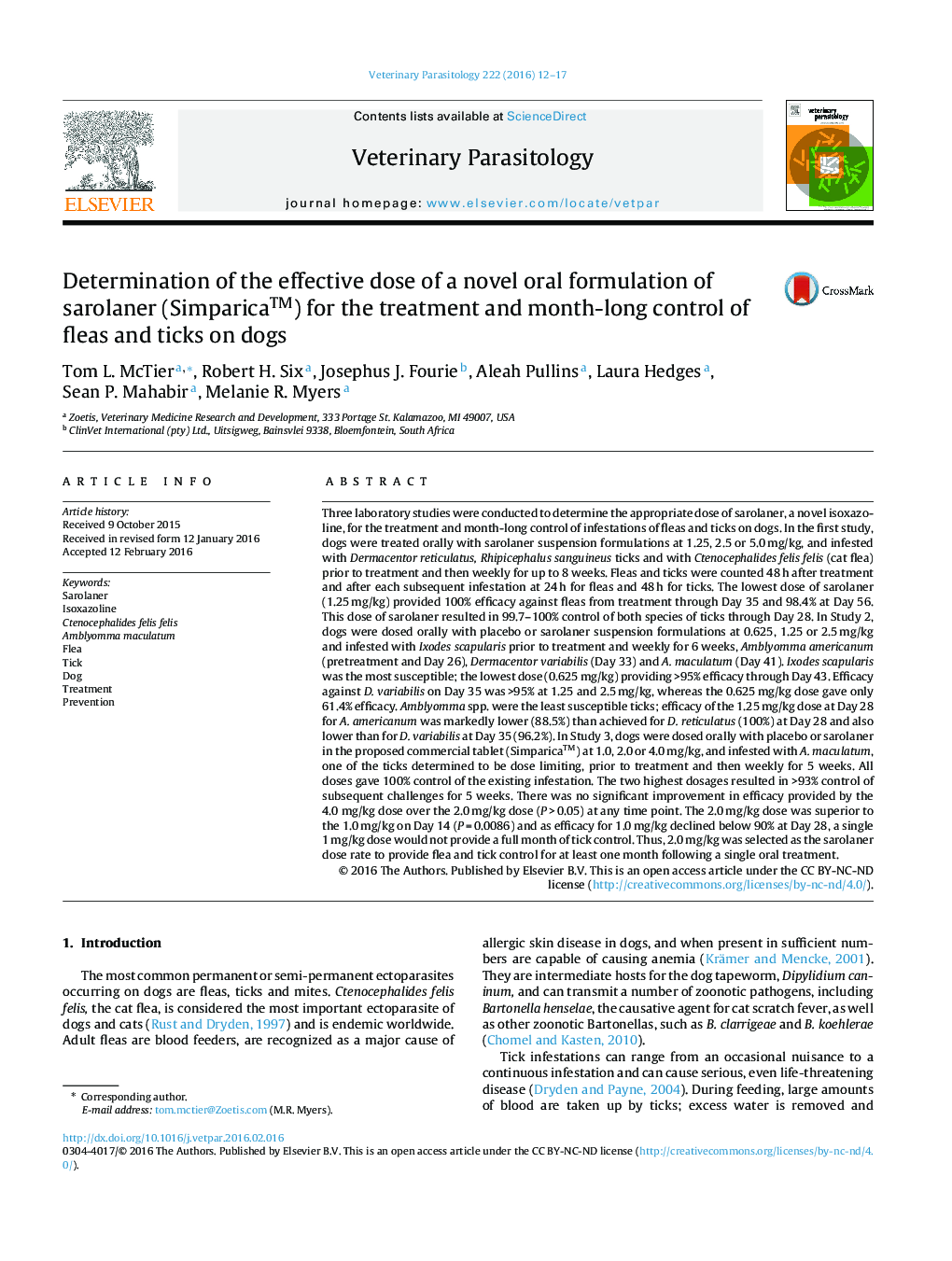| کد مقاله | کد نشریه | سال انتشار | مقاله انگلیسی | نسخه تمام متن |
|---|---|---|---|---|
| 2469833 | 1555654 | 2016 | 6 صفحه PDF | دانلود رایگان |

• Doses (0.625–5 mg/kg) of sarolaner were tested to assess efficacy against fleas and ticks for one month.
• Fleas were susceptible and Amblyomma spp. were the least sensitive of the ticks tested.
• Amblyomma maculatum was selected for dose determination.
• 2 mg/kg resulted in >90% control of A. maculatum for >4 weeks.
• 2 mg/kg was selected as the dose for one month control of fleas and ticks.
Three laboratory studies were conducted to determine the appropriate dose of sarolaner, a novel isoxazoline, for the treatment and month-long control of infestations of fleas and ticks on dogs. In the first study, dogs were treated orally with sarolaner suspension formulations at 1.25, 2.5 or 5.0 mg/kg, and infested with Dermacentor reticulatus, Rhipicephalus sanguineus ticks and with Ctenocephalides felis felis (cat flea) prior to treatment and then weekly for up to 8 weeks. Fleas and ticks were counted 48 h after treatment and after each subsequent infestation at 24 h for fleas and 48 h for ticks. The lowest dose of sarolaner (1.25 mg/kg) provided 100% efficacy against fleas from treatment through Day 35 and 98.4% at Day 56. This dose of sarolaner resulted in 99.7–100% control of both species of ticks through Day 28. In Study 2, dogs were dosed orally with placebo or sarolaner suspension formulations at 0.625, 1.25 or 2.5 mg/kg and infested with Ixodes scapularis prior to treatment and weekly for 6 weeks, Amblyomma americanum (pretreatment and Day 26), Dermacentor variabilis (Day 33) and A. maculatum (Day 41). Ixodes scapularis was the most susceptible; the lowest dose (0.625 mg/kg) providing >95% efficacy through Day 43. Efficacy against D. variabilis on Day 35 was >95% at 1.25 and 2.5 mg/kg, whereas the 0.625 mg/kg dose gave only 61.4% efficacy. Amblyomma spp. were the least susceptible ticks; efficacy of the 1.25 mg/kg dose at Day 28 for A. americanum was markedly lower (88.5%) than achieved for D. reticulatus (100%) at Day 28 and also lower than for D. variabilis at Day 35 (96.2%). In Study 3, dogs were dosed orally with placebo or sarolaner in the proposed commercial tablet (Simparica™) at 1.0, 2.0 or 4.0 mg/kg, and infested with A. maculatum, one of the ticks determined to be dose limiting, prior to treatment and then weekly for 5 weeks. All doses gave 100% control of the existing infestation. The two highest dosages resulted in >93% control of subsequent challenges for 5 weeks. There was no significant improvement in efficacy provided by the 4.0 mg/kg dose over the 2.0 mg/kg dose (P > 0.05) at any time point. The 2.0 mg/kg dose was superior to the 1.0 mg/kg on Day 14 (P = 0.0086) and as efficacy for 1.0 mg/kg declined below 90% at Day 28, a single 1 mg/kg dose would not provide a full month of tick control. Thus, 2.0 mg/kg was selected as the sarolaner dose rate to provide flea and tick control for at least one month following a single oral treatment.
Journal: Veterinary Parasitology - Volume 222, 30 May 2016, Pages 12–17